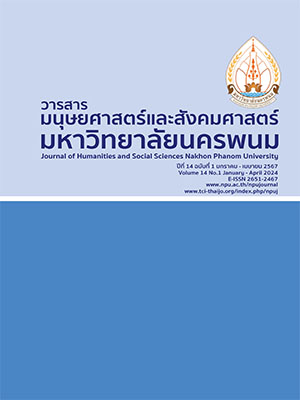Integrating Coding in the ADDIE Model for Instructional Media Development for Students with Intellectual and/or Autistic Disabilities
Main Article Content
Abstract
The purpose of this research was twofold: firstly, to analyze the problems and learning needs of students with intellectual and/or autistic disabilities using the ADDIE model, and secondly, to integrate coding into the instructional media development for these students within the ADDIE framework. The research followed the research and development process, encompassing the ADDIE model's five steps: analysis (A), design (D), development (D), implementation (I), and evaluation (E). The target group comprised 13 teachers responsible for teaching science and technology to students with intellectual and/or autistic disabilities across four schools—Chachoeng Panyanukul School, Kalasin Panyanukul School, Kawila Anukul School, and Nakornsrithammarat Panyanukul School—selected through purposive sampling. Research instruments included lesson planning for developing instructional media and a 5-point Likert scale questionnaire. Qualitative data underwent content analysis, while quantitative data were analyzed using descriptive statistics, including Mean (x̅)and standard deviation (S.D.). The results revealed the development of four instructional media items using the ADDIE model: the shadow matching board, the life cycle of the butterfly, the parts of a plant, and the five food groups. The parts of a plant and the five food groups instructional medias were deemed appropriate at the highest levels (x̅ = 4.58, S.D. = 0.53) and (x̅ = 4.72, S.D. = 0.44), respectively. The shadow matching board and the life cycle of the butterfly were appropriate at high levels (x̅ = 4.48, S.D. = 0.56) and (x̅ = 4.44, S.D. = 0.60), respectively.
Article Details

This work is licensed under a Creative Commons Attribution-NonCommercial-NoDerivatives 4.0 International License.
References
Ayu Sari Puspita, L. P., Padmadewi, N. N. and Eka Wahyuni, L. G. (2019). Instructional Teaching Media to Promote Autistic Student’s Learning Engagement. Journal of Educational Research and Evaluation. 3(2),58-65. doi:10.23887/jere.v3i2.20975
Best, J. W. (1981). Research in education. (4th ed). New Jersy : Prentice Hall.
Branch, R. M. (2009). Instructional Design: The ADDIE Approach. New York : Springer.
Chansrisukot, C. (2019). Kānčhatkānrīanrūsāhō̜rapdekthīmīkhwāmbokphrō̜ngthāngkānrīanrū [Management of Learning for Children with Learning Disabilities]. Retrieved July 2023, from https://portal5.udru. ac.th/ebook/pdf/upload/18KFNoun5x41o7iu1wJ3.pdf.
Daryanes, F. et al. (2023). The development of artificial storyline interactive learning media based on case methods to train student’s problem-solving ability. Retrieved January 2023, from https://doi.org/ 10.1016/j.heliyon.2023.e15082.
Gomaa, M. K. O. (2020). The Effect of Differentiating Instruction Using Multiple Intelligences on Achievement in and Attitudes towards Science in Middle School Students with Learning Disabilities. Retrieved July 2023, from https://www.semanticscholar.org/paper/The-Effect-of-Differentiating-Instruction-Using-on-Gomaa/c8cf880d6cef5adba30da2a727f8307d872b7cb9.
Heath, B. (2022). Chapter 08: Designing with Disabilities in Mind. Instructional Message Design. 2(8),196-214. https://digitalcommons.odu.edu/instructional_message_design_vol2/8/.
Jame, K. (2023). Why teach coding? Who should teach it? And how can teachers get started? Get tips on how to bring coding into your classroom. Retrieved August 2023, from https://www.common sense.org/education/articles/teachers-essential-guide-to-coding-in-the-classroom.
Joungburanasit, S. (2020). Kānchai rūpbǣp kānsō̜n ADDIE Model phư̄a kān prapprung læ phatthanākān rīan kānsō̜n phāsā Čhīn hai sō̜tkhlō̜ng kap satawat thī yīsipʻet [Utilizing the ADDIE Model for Improving and Developing Chinese Language Teaching and Learning to Align with the 21st Century]. The 2nd National Conference on Humanities and Social Sciences - Humanities and Social Sciences: Innovation for Social Creation. Retrieved July 2023, from https://human.skru.ac.th/husoconference /conf/P7.pdf.
Marlina, M. (2019). Peer Mediated Intervention for Improving Social Skills of Children with Learning Disabilities in Inclusive Elementary School. Jurnal Pendidikan Humaniora. 2(4),368-382.
Morgan, H. (2020). Maximizing student success with differentiated learning. Clear House. 87(1),34-38. https://doi.org/10.1080/00098655.2013.832130.
Muruganantham, G. (2019). Developing of E-content package by using ADDIE model. International Journal of Applied Research. 1(3),52-54.
Office of the Education Council. (2021). Nǣothāng kān songsœ̄m kānčhatkān rīan kānsō̜n witthayākān khamnūan Coding phư̄a phatthanā thaksa phū rīan nai satawat thī 21. [Guidelines for Promoting Teaching and Learning Management of Computational Coding to Develop Students' Skills in the 21st Century]. Bangkok : 21st Century Company Limited.
Rayanto, Y. H., Supriyo, and Sugianti (2020). Applying Objectivist Instructional Design of Addie Model on Learning Reading Comprehension. Advances in Social, Education and Humanities Research. 477, 795-799. doi:10.2991/assehr.k.201017.175.
Sahaat, Z., Nasri, M. N., and Bakar, A. Y. A. (2019). ADDIE Model In Teaching Module Design Process Using Modular Method: Applied Topics in Desing And Technology Subjects. Advances in Social Science, Education and Humanities Research. 464,719-724. doi:10.2991/assehr.k.200824.161.
Servilio, K. (2020). You get to choose! Motivating students to read through differentiated instruction. Teaching Exceptional Children plus. 5(5),2-11.
Soong, D. (2019). A Study on EFL Students’ Use of E-Learning Programs for Learning English – Taking a Taiwanese University as an Example. English Language Teaching. 5(4),87-95. doi:10.5539/elt. v5n4p87.
Stapa, A. M. and Mohammad, N. (2019). The Use of ADDIE Model for Designing Blended Learning Application at Vocational Colleges in Malaysia. Asia-Pacific Journal of Information Technology and Multimedia. 8(1),49-62. doi: 10.17576/apjitm-2019-0801-05.
Thongphanich, P. (2017). Wichākānʻō̜kbǣp lækān čhatkān rīanrū naichanrīan [Academic Design and Classroom Learning Management]. (3rd ed). Nakhon Pathom : Silpakorn University Sanam Chandra Palace Campus Pubisher.
Tomlinson, C. A. (2001). How to Differentiate Instruction in Mixed-Ability Classrooms. (2nd ed). Virginia : ASCD publications.
Wahyudin, D., Darmawan D., and Suharti. (2022). Design of e-Learning based Based on ADDIE model during the Covid-19 Pandemic. Communication, technologies et development. (11),1-20. https://doi.org/ 10.4000/ctd.7556.
Wang, B. S., and Hsu, H. (2019). Using the ADDIE Model to Design Second Life Activities for Online Learners. TechTrends. 53(6),76-81. doi:10.1007/s11528-009-0347-x.
Wiboolyasin, W. (2021). Lakkān ʻō̜k bǣp kānsō̜n bon wep tām bǣpčhamlō̜ng ADDIE phư̄a kānsō̜n sonthanā phāsā Thai bư̄angton samrap chāo tāngprathēt [A Web-based Instructional Design Principle Based on ADDIE Model to Teach Fundamental THAI Conversation for Foreigners]. Srinakharinwirot Research and Development (Journal of Humanities and Social Sciences). 6(12),192-205.


